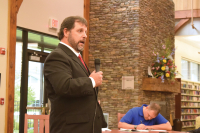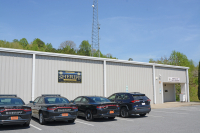Drilling down: construction cost balloons for HCC’s fire and rescue training center
 The construction cost for a new fire and rescue training center at Haywood Community College has clocked in more than $1 million higher than expected, prompting soul searching among college leaders and county commissioners over whether to go ahead with the project as planned.
The construction cost for a new fire and rescue training center at Haywood Community College has clocked in more than $1 million higher than expected, prompting soul searching among college leaders and county commissioners over whether to go ahead with the project as planned.
The fire and rescue training center has been talked about for more than a decade, with planning beginning in earnest three years ago.
“We do not want to see the momentum go away,” HCC board chairman Richard Lanning said during a meeting between the college and county leaders last week. “We are teaching people to save lives.”
The center will host required certification and training courses for firefighters, rescue workers, law enforcement, SWAT teams, emergency medical technicians and prison guards, with sets and props for acting out simulated scenarios.
“I don’t think there is any question that there’s considerable worth in the public safety arena for a facility like this,” Commissioner Mark Swanger replied. “And I understand it is going to cost money.”
The cost of the new training center was initially projected at $4 million, based on estimates from the contracted architect firm. But when bids came in from contractors last month, the lowest one put the project at $5.4 million.
Related Items
“Unfortunately, we received quite a surprise. They of course are concerned it has come in significantly over budget,” HCC President Dr. Barbara Sue Parker said.
Commissioner Bill Upton asked whether options for cost savings had already been explored.
“Can you build it any cheaper?” Upton asked.
Parker said the plan was carefully vetted by a design committee, including a cross-section of fire, rescue and law enforcement representatives in the county. The committee had already pared down elements of the project as it is, and paring it down more would compromise its purpose and intent, according to Waynesville Fire Chief Joey Webb, who was on the committee.
“We come in and cut away and cut away to what we felt like we absolutely had to have,” Webb said. “We tried to look at this thing and make it marketable to draw firefighters in from around the state.”
One of the most moving soliloquies of the hour-long discussion at the commissioner’s meeting was delivered by Chief Deputy Jeff Haynes with the Haywood County Sheriff’s Office, who took an impromptu turn at the mic to put the import of the project in focus.
“For 20 years this issue has been on the table. We have watched it ebb and flow. We have watched it start. We’ve watched it stop. At some point it is time to step forward,” Haynes said. “This is a step we can take to improve quality of life for the people of Haywood County and do the right thing.”
Haynes cited the sacrifices made by legions of volunteer firefighters and rescue workers in the county, as well as law enforcement officers, who put their own safety on the line and give up time away from their jobs and families to serve the community.
“We have an opportunity to make an impression on not only the community but to the firefighters, to the rescue volunteer, to the medics, to the law enforcement officers in this county, to show once again that we support them by giving them a facility to train in and reward them for taking care of the citizens of this county,” Haynes said.
HCC isn’t the only one who’s seeing bids from contractors come back more than anticipated lately.
“We have been seeing a lot higher prices statewide,” said Latif Kaid, assistant director of the N.C. State Construction Office. “It is just the market and the contractors’ availability, and also material cost has been going up this summer.”
Asking for help
When Parker shared the conundrum at the county commissioners meeting last week, the HCC board of trustees hadn’t yet voted on whether to bite the bullet and do the project anyway, despite the cost.
They were leaning toward it, but had a question to ask commissioners first: would the county help with the additional operation expenses of the training center in the future?
Parker said with the higher construction cost of eating up more money, HCC would be stretched too thin to also come up with the higher maintenance and staffing expenses out of its own pocket.
“One of the concerns expressed by our board was the yearly operations and maintenance,” Parker said.
It will cost about $126,000 a year to run the fire and rescue training center — primarily due to the specialized burn tower, which would get a beating from gas-fueled pyrotechnics, smoke machines and a regular dousing with water and fire retardants.
The college will have to hire a full-time staff person to run the burn tower, due to its specialized nature. It would also come with the additional upkeep, maintenance and cleaning.
“If I understand correctly, if you don’t operate this thing properly, you burn up your burn facility and you don’t have it anymore,” Commissioner Kirk Kirkpatrick said.
The college wanted a pledge that the county would increase HCC’s budget accordingly to help cover the added operational costs. But that wouldn’t be needed until 2017, and a commissioners’ election would occur between now and then.
Swanger said the commissioners today couldn’t make a definitive promise to HCC whether future commissioners would increase the college’s budget for operations.
“You can’t bind another board into the future,” Swanger said.
Commissioner Mike Sorrells asked whether the college would likely see an increase in the number of agencies from around the state coming to train at the facility, and thus be able to bring in more money to cover the added cost.
Parker replied that by law they can’t charge fire, rescue and law enforcement officers for the trainings. Although every hour of training adds to their total student count, which in turn means more state per pupil dollars, it is nominal — only enough to cover the cost of paying instructors and general overhead.
“What you are saying is we have no way to cover this additional expense and there is no way to charge most of these folks so you don’t have any income to offset these expenses,” Kirkpatrick summed up.
Borrowing against the future
Money to build the fire and rescue training center will come out of a special quarter-cent sales tax specific to Haywood County. Haywood voters approved the quarter-cent sales tax several years ago, on the understanding it would be dedicated for community college building projects.
The new higher price tag for the project would eat up every bit of the sales tax for the next decade.
“That is my biggest concern,” said Upton. “You are still going to have needs at the college.”
Commissioners wanted to know what projects might be compromised down the road by committing more money to the fire and rescue training center today.
“What is the next big project that potentially needs to be done or that you would like to have done?” Sorrells asked.
Parker said HCC wants to renovate the space that houses the nursing program and build a new general classroom building.
Swanger then brought up a sore point among commissioners: the $11 million creative arts building HCC undertook several years ago.
Commissioners were at bitter odds with HCC leaders at the time over the cost of that project. The county attempted to send the college back to the drawing board, claiming the building design was too extravagant, but college leaders countered that the project couldn’t be cut without compromising the flagship nature of the building, including its many eco features.
Swanger said if anything could be blamed for eating up the quarter-cent sales tax pot, it’s the big price tag on the creative arts building — not the law enforcement training center.
“I would hate for a public safety training facility to be blamed for preventing future projects when we all remember the creative arts building. That’s where the problem occurred. It is not this facility, so I want to put that out there,” Swanger said.
The creative arts building houses students earning degrees in jewelry-making, pottery, woodworking and other craft enterprises. Parker noted that the creative arts program does draw students from outside the area to HCC more so than any other field.
Kirkpatrick said he supports the fire and rescue training center. But that doesn’t change the reality that there’s only so much money available through the quarter-cent sales tax, piling onto the thread that the creative arts building was the real culprit, however.
“I am not trying to be negative toward the college board now at all, because it wasn’t this board that made those decisions,” Kirkpatrick said. “What we want to be careful of is supporting this project and then later on being asked for additional funds because the community college doesn’t have the funds to improve the nursing facility.”
Parker agreed.
“We have had the very same conversations. There is only so much money and a bunch of needs,” Parker said.
There’s nothing to say the county has to cap building projects at HCC to the pot of money generated by the quarter-cent sales tax. Few counties have a dedicated pot of money for community college facilities, and simply dredge up the money from their normal county coffers. The commissioners could always add to what’s generated from the quarter-cent sales tax if they chose.
Likewise, there’s nothing binding county commissioners to actually set the quarter-cent sales tax aside for the college. Legally, strings can’t be attached to it.
But that was the pitch to voters, and commissioners thus far have allowed the community college to use the quarter-cent sales tax revenue on the building projects of their choosing.
Swanger said the fire, rescue and law enforcement community came out in support of the quarter-cent sales tax when it was on the ballot, based on promises that this training center would eventually come to fruition using that pot of money.
“I don’t know how you go back on that. I just don’t know how you do that,” Swanger said.
“This is something that has been promised to the community,” Kirkpatrick agreed.
“The tough questions don’t indicate where our heart is,” Upton assured.
In the end, HCC leaders got the modicum of assurance they needed — both that the commissioners were philosophically behind them and that the county would look favorably on a budget increase in the future to help cover the operations of the burn tower.
The community college board met last week following the discussion with commissioners and unanimously voted to award the construction to Brantley Construction of Canton, which came in with the lowest bid.
“The Public Services Training Facility is one that will dramatically impact the safety and well-being of our entire community,” Lanning said. “While the project will require a large portion of our capital funding for a number of years, its level of importance in relation to the safety of Haywood County is why we’re committed to moving forward.”
Features of the proposed training center
- The crown-jewel of the HCC fire and rescue training center is a burn tower where firefighters can battle simulated fires complete with smoke, explosions and dummies that need saving. The tower can also be used for SWAT scenarios, whether it’s sweeping a building for a rouge gunman or rappelling into windows to rescue hostages.
- There’s also a mock-up of a jail cell, a space to act-out attic fire drills and an extraction pad built into a hillside to allow rescue workers to practice pulling bodies from wrecked vehicles on a steep slope.
- There will also be classroom space, garage bays for rescue vehicles and a training floor for medical technicians.









